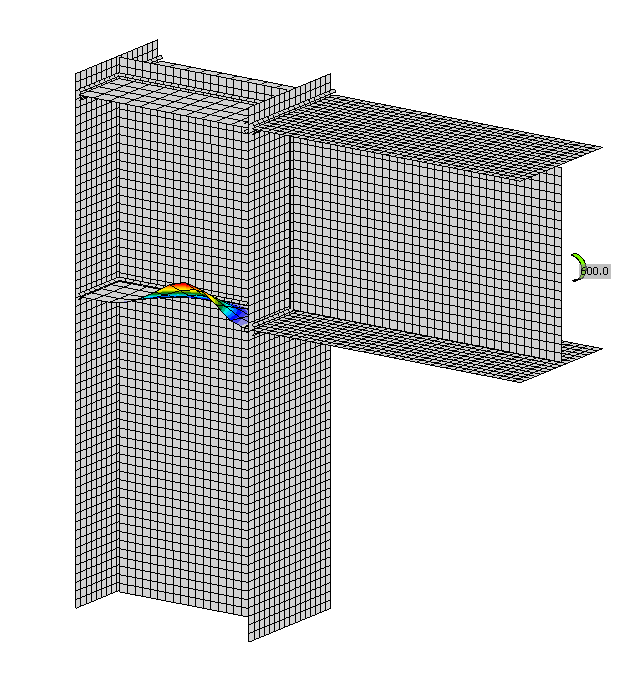Description
The objective of this study is a verification of component-based finite element method (CBFEM) of a class 4 column web stiffener in a beam-to-column joint with a research FEA model (RFEM) created in Dlubal RFEM software and component method (CM).
Research FEA model
Research FEA model (RFEM) is used to verify the CBFEM model. In the numerical model, 4-node quadrilateral shell elements with nodes at its corners are applied. Geometrically and materially nonlinear analysis with imperfections (GMNIA) is applied. Equivalent geometric imperfections are derived from the first buckling mode, and the amplitude is set according to Annex C in EN 1993-1-5:2006. The numerical model is shown in Fig. 6.3.1.
\[ \textsf{\textit{\footnotesize{Fig. 6.3.1 Research FEA model of a beam-to-column joint with slender column web stiffener}}}\]
CBFEM
The design procedure for slender plates is described in section 3.10. The linear buckling analysis is implemented in the software. The calculation of the design resistances is done according to the design procedure. FCBFEM is interpolated by the user until ρ ∙ αult,k/γM1 is equal to 1. A beam-to-column joint with a slender column web stiffener is studied. The same cross-section is used for the beam and the column. The thickness of the column web stiffener is changing. The geometry of the examples is described in Tab. 6.3.1. The joint is loaded by bending moment.
Tab. 6.3.1 Examples overview
| Example | Column/beam flange | Column/beam web | Stiffener | Material | ||
| bf | tf | hw | tw | ts | ||
| [mm] | [mm] | [mm] | [mm] | [mm] | ||
| t3 | 400 | 20 | 600 | 12 | 3 | S235 |
| t4 | 400 | 20 | 600 | 12 | 4 | S235 |
| t5 | 400 | 20 | 600 | 12 | 5 | S235 |
| t6 | 400 | 20 | 600 | 12 | 6 | S235 |
Global behavior and verification
The global behavior of a beam-to-column joint with a slender column web stiffener of thickness 3 mm described by moment-rotation diagram in CBFEM model is shown in Fig. 6.3.2. Attention is focused on the main characteristics: design resistance and critical load. The diagram is completed with a point where yielding starts and resistance by 5 % plastic strain.
\[ \textsf{\textit{\footnotesize{Fig. 6.3.2 Moment-rotation curve of example t3}}}\]
Verification of resistance
The design resistance calculated by CBFEM Idea StatiCa software is compared with RFEM. The comparison is focused on the design resistance and critical load. The results are ordered in Tab. 6.3.2. The diagram in Fig. 6.3.3 c) shows the influence of the thickness of the column web stiffener on the resistances and critical loads in the examined examples.
Tab. 6.3.2 Design resistances and critical loads of RFEM and CBFEM
The results show very good agreement in critical load and design resistance. The CBFEM model of the joint with web stiffener with the thickness of 3 mm is shown in Fig. 6.3.3a. The first buckling mode of the joint is shown in Fig. 6.3.3b.
\[ \textsf{\textit{\footnotesize{a)}}}\]
\[ \textsf{\textit{\footnotesize{b)}}}\]
\[ \textsf{\textit{\footnotesize{c)}}}\]
\[ \textsf{\textit{\footnotesize{Fig. 6.3.3 a) Geometrical model b) First buckling mode c) Influence of stiffener’s thickness on resistances and critical loads}}}\]
Verification studies confirmed the accuracy of the CBFEM model for the prediction of a column web stiffener behavior. The results of CBFEM are compared with the results of the RFEM. All procedures predict similar global behavior of the joint. The difference in design resistance is in all cases below 10%.
Benchmark example
Inputs
Beam
- Steel S235
- Flange thickness tf = 20 mm
- Flange width bf = 400 mm
- Web thickness tw = 12 mm
- Web height hw = 600 mm
Column
- Steel S235
- Flange thickness tf = 20 mm
- Flange width bf = 400 mm
- Web thickness tw = 12 mm
- Web height hw = 560 mm
- Section height h = 600 mm
Upper column web stiffener
- Steel S235
- Stiffener thickness tw = 20 mm
- Stiffener width hw = 400 mm
Lower column web stiffener
- Steel S235
- Stiffener thickness tw = 3 mm
- Stiffener width hw = 400 mm
Code setup – Model and mesh
- Number of elements on biggest member web or flange 24
Outputs
- Plastic resistance CBFEM = 589 kNm
- Design buckling resistance CBFEM (kNm) = 309 kNm
- Critical buckling factor (for design buckling resistance = 309 kNm) αcr = 0,97
- Load factor by 5 % plastic strain αult,k = Plastic resistance CBFEM / Design buckling resistance CBFEM = 589/309 = 1,91







